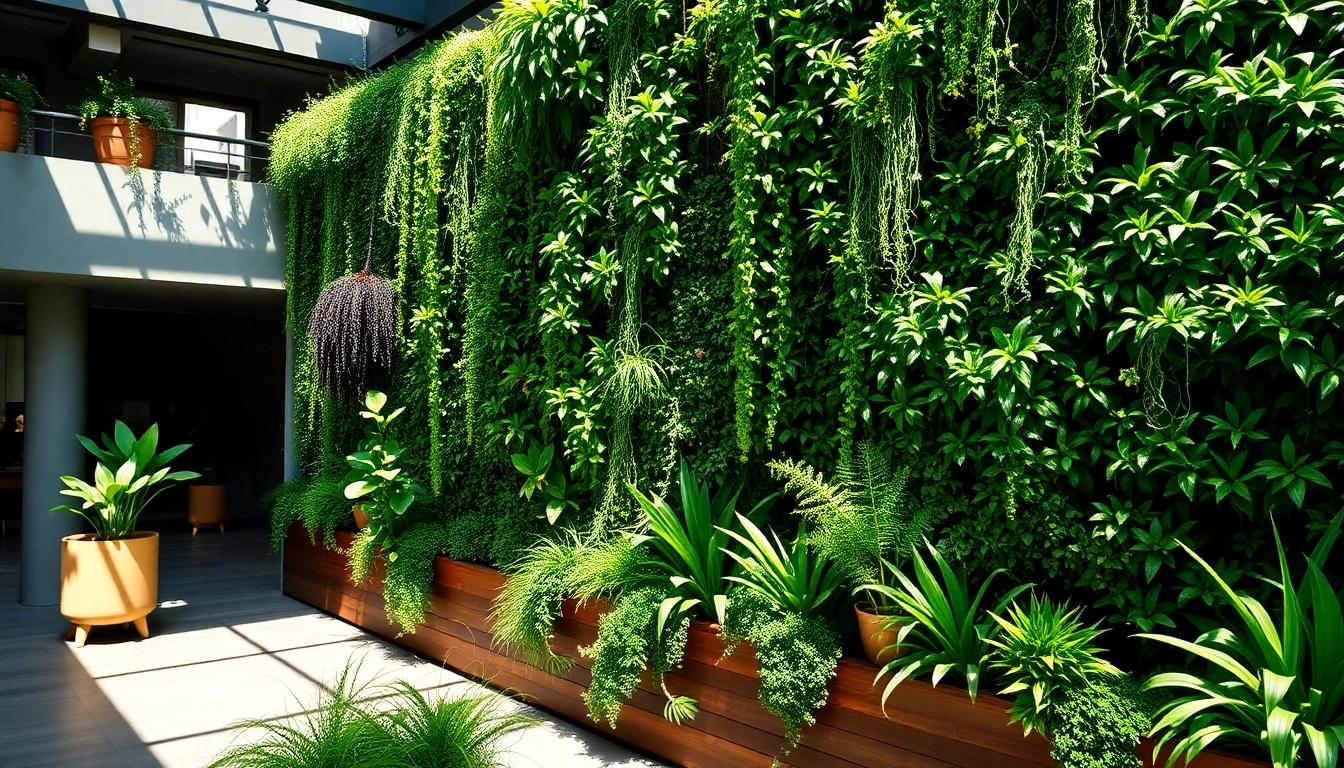Understanding Vertikale Gärten
In today’s urban environments, where space is limited and greenery often takes a backseat to concrete and steel, vertical gardens, known as vertikale Gärten, have emerged as a revolutionary solution. These innovative garden designs utilize vertical space, allowing individuals to cultivate plants in a manner that not only beautifies the surroundings but also promotes environmental benefits. In this comprehensive guide, we will delve into the essence of vertical gardens, their advantages, the best plants to use, and much more, empowering you to create your green oasis amidst the hustle and bustle of urban life.
What are Vertikale Gärten?
Vertikale Gärten, or vertical gardens, are a unique gardening technique where plants are grown upwards on walls or trellises instead of the traditional horizontal ground space. This method allows for various plant species to cohabitate and thrive in a small area, transforming walls or fences into living green canvases. Vertical gardens can be implemented on both small residential balconies and large commercial buildings, providing versatility and adaptability to different spaces.
Benefits of Vertical Gardens
Vertical gardening offers a multitude of benefits that can greatly enhance both personal and communal spaces. Here are some of the key advantages:
- Space Efficiency: Ideal for urban dwellers with limited garden space, vertical gardens maximize available area.
- Air Quality Improvement: Plants absorb carbon dioxide and release oxygen, contributing to cleaner air.
- Noise Reduction: The foliage acts as a sound barrier, reducing noise pollution, thereby creating a more peaceful environment.
- Temperature Regulation: Vertical gardens help cool the air and reduce the heat in urban settings, thereby lowering energy costs.
- Aesthetic Appeal: They add beauty and character to spaces that would otherwise be bland and uninviting.
Common Plants for Vertical Gardening
Selecting the right plants is crucial to the success of your vertical garden. Here are some popular choices:
- Pothos: A hardy vine that’s easy to grow and maintains its lush appearance in various light conditions.
- Ferns: They thrive in shadier spots and bring a touch of the wildness to vertical gardens.
- Succulents: Perfect for sunny areas, they require minimal care and add unique textures and colors.
- Herbs: Culinary herbs like basil and thyme are not only practical for cooking but also great for indoor air quality.
- Flowering Plants: Incorporate species like geraniums or petunias for vibrant colors and fragrances.
How to Design Your Vertikale Gärten
Designing a vertical garden involves careful planning and creativity. Here are key considerations to keep in mind:
Choosing the Right Location
Determining the best location for your vertical garden is fundamental. Consider the following:
- Sunlight: Assess the sun exposure in your intended area. Most plants require a minimum of six hours of sunlight daily.
- Accessibility: Ensure easy access for maintenance. A garden that’s hard to reach is more likely to be neglected.
- Wind Protection: High winds can damage delicate plants; seek areas that offer some level of shelter.
Design Principles for Vertical Gardens
To create a visually appealing vertical garden, follow these design principles:
- Layering: Combine plants of varying heights and textures to create depth and dimension.
- Color Palette: Choose a cohesive color scheme to ensure your garden is aesthetically pleasing.
- Modular Systems: Utilize modular planting systems for easier maintenance and rearrangement if needed.
Integrating Features: Watering Systems & Lights
Adding features like automated watering systems and grow lights can significantly enhance your vertical garden:
- Watering Systems: Drip irrigation or self-watering systems can ensure consistent moisture without overwatering.
- Grow Lights: If natural sunlight is limited, consider installing grow lights to provide adequate light for photosynthesis.
Implementing Your Vertical Garden
Bringing your vertical garden vision to life involves several steps and the right tools. Here’s a guide to help you through the implementation process:
Step-by-Step Installation Guide
Follow these steps to ensure a successful installation:
- Preparation: Choose your plants and design, and gather all necessary tools and materials.
- Construct the Framework: Build or install your vertical frame or select a ready-made vertical garden kit.
- Soil and Planting: Use quality soil and plant your chosen specimens according to your design plan.
- Install Watering Systems: Connect your irrigation system and test for proper water distribution.
- Add Lighting: Set up grow lights as required, ensuring they provide adequate coverage for your plants.
- Initial Watering: Water your plants thoroughly after installation to help them settle.
Tools and Materials Required
To successfully create your vertical garden, you will need some essential tools and materials, including:
- Plant pots and liners
- Vertical gardening systems or trellises
- Quality potting soil and amendments
- Watering can or irrigation system components
- Garden gloves and basic gardening tools (trowel, scissors, etc.)
Best Practices for Setup
Keep the following best practices in mind during your setup:
- Always begin with a clean workspace to prevent plant disease.
- Follow spacing guidelines for each plant type to prevent overcrowding.
- Monitor the moisture levels closely for the first few weeks after installation.
Maintenance Tips for Healthy Vertikale Gärten
Proper maintenance is key to ensuring the longevity and vitality of your vertical garden. Here are some critical tips:
Watering and Nutritional Needs
Each plant type has different watering and nutritional demands. Here are some general guidelines:
- Check soil moisture regularly; it should be damp but not soggy.
- Incorporate a slow-release fertilizer during the growing season to support plant growth.
- Adjust watering frequency based on environmental conditions, such as heat and humidity.
Pest Management in Vertical Gardens
Pests can pose serious threats to vertical gardens, requiring vigilant monitoring and preventive measures:
- Regularly inspect plants for signs of pests and disease.
- Utilize organic pest control methods when necessary, such as neem oil or insecticidal soap.
- Encourage beneficial insects like ladybugs that naturally keep pest populations in check.
Seasonal Care and Upkeep
Adapting your care routine to seasonal changes is essential:
- In spring, focus on replanting and fertilization as plants emerge from dormancy.
- In the summer, monitor for watering needs due to warmer temperatures.
- Autumn may require trimming back certain plants and preparing them for winter.
- During winter, reduce watering and ensure all plants are well-protected from frost.
Showcasing Successful Vertikale Gärten Projects
Inspiration can often come from successful implementations of vertical gardens worldwide. Here are some notable projects:
Inspirational Vertical Gardens Around the World
Various cities globally have embraced vertical gardening, showcasing stunning designs that blend nature with architecture:
- Mur Vegetal: Paris boasts this impressive vertical garden covering the Quai Branly Museum, adorned with over 15,000 plants.
- One Central Park: This Sydney project features vertical gardens integrated into its residential buildings, promoting sustainability.
- Bosco Verticale: Milan’s iconic “Vertical Forest,” featuring residential towers adorned with trees and plants.
Case Studies: Homeowners’ Experiences
Hearing firsthand accounts can offer invaluable insights into the vertical gardening experience:
- Many homeowners report increased enjoyment of their living spaces and enhanced property value after installing vertical gardens.
- Some have shared their challenges, including initial learning curves, but the aesthetic and ecological benefits greatly outweigh these.
- Community gardens have also formed around vertical gardening initiatives, fostering connections among neighbors.
Interviews with Expert Garden Designers
Experts in the field provide a wealth of knowledge and innovative ideas on vertical gardening:
- Professional landscape designers advocate for starting small and experimenting with various plant types to understand growth requirements.
- They suggest consulting local horticulturalists for plant recommendations that thrive well in specific regions.
- Many emphasize the importance of visual composition, encouraging homeowners to play with color and texture for a more engaging garden.



